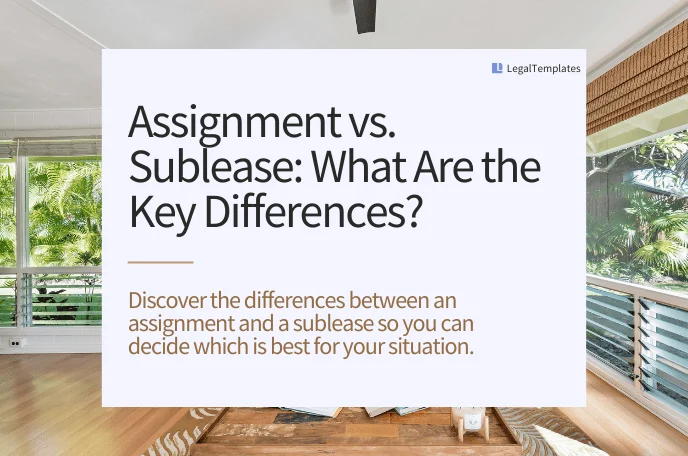

Assignment of Lease: How It Works and Parties Involved
Jump to section, what is an assignment of lease.
The assignment of lease is a title document that transfers all rights possessed by a lessee or tenant to a property to another party. The assignee takes the assignor’s place in the landlord-tenant relationship.
You can view an example of a lease assignment here .
How Lease Assignment Works
In cases where a tenant wants to or needs to get out of their lease before it expires, lease assignment provides a legal option to assign or transfer rights of the lease to someone else. For instance, if in a commercial lease a business leases a place for 12 months but the business moves or shuts down after 10 months, the person can transfer the lease to someone else through an assignment of the lease. In this case, they will not have to pay rent for the last two months as the new assigned tenant will be responsible for that.
However, before the original tenant can be released of any responsibilities associated with the lease, other requirements need to be satisfied. The landlord needs to consent to the lease transfer through a “License to Assign” document. It is crucial to complete this document before moving on to the assignment of lease as the landlord may refuse to approve the assignment.
Difference Between Assignment of Lease and Subletting
A transfer of the remaining interest in a lease, also known as assignment, is possible when implied rights to assign exist. Some leases do not allow assignment or sharing of possessions or property under a lease. An assignment ensures the complete transfer of the rights to the property from one tenant to another.
The assignor is no longer responsible for rent or utilities and other costs that they might have had under the lease. Here, the assignee becomes the tenant and takes over all responsibilities such as rent. However, unless the assignee is released of all liabilities by the landlord, they remain responsible if the new tenant defaults.
A sublease is a new lease agreement between the tenant (or the sublessor) and a third-party (or the sublessee) for a portion of the lease. The original lease agreement between the landlord and the sublessor (or original tenant) still remains in place. The original tenant still remains responsible for all duties set under the lease.
Here are some key differences between subletting and assigning a lease:
- Under a sublease, the original lease agreement still remains in place.
- The original tenant retains all responsibilities under a sublease agreement.
- A sublease can be for less than all of the property, such as for a room, general area, portion of the leased premises, etc.
- Subleasing can be for a portion of the lease term. For instance, a tenant can sublease the property for a month and then retain it after the third-party completes their month-long sublet.
- Since the sublease agreement is between the tenant and the third-party, rent is often negotiable, based on the term of the sublease and other circumstances.
- The third-party in a sublease agreement does not have a direct relationship with the landlord.
- The subtenant will need to seek consent of both the tenant and the landlord to make any repairs or changes to the property during their sublease.
Here is more on an assignment of lease here .
Parties Involved in Lease Assignment
There are three parties involved in a lease assignment – the landlord or owner of the property, the assignor and the assignee. The original lease agreement is between the landlord and the tenant, or the assignor. The lease agreement outlines the duties and responsibilities of both parties when it comes to renting the property. Now, when the tenant decides to assign the lease to a third-party, the third-party is known as the assignee. The assignee takes on the responsibilities laid under the original lease agreement between the assignor and the landlord. The landlord must consent to the assignment of the lease prior to the assignment.
For example, Jake is renting a commercial property for his business from Paul for two years beginning January 2013 up until January 2015. In January 2014, Jake suffers a financial crisis and has to close down his business to move to a different city. Jake doesn’t want to continue paying rent on the property as he will not be using it for a year left of the lease. Jake’s friend, John would soon be turning his digital business into a brick-and-mortar store. John has been looking for a space to kick start his venture. Jake can assign his space for the rest of the lease term to John through an assignment of lease. Jake will need to seek the approval of his landlord and then begin the assignment process. Here, Jake will be the assignor who transfers all his lease related duties and responsibilities to John, who will be the assignee.
You can read more on lease agreements here .

Image via Pexels by RODNAE
Assignment of Lease From Seller to Buyer
In case of a residential property, a landlord can assign his leases to the new buyer of the building. The landlord will assign the right to collect rent to the buyer. This will allow the buyer to collect any and all rent from existing tenants in that property. This assignment can also include the assignment of security deposits, if the parties agree to it. This type of assignment provides protection to the buyer so they can collect rent on the property.
The assignment of a lease from the seller to a buyer also requires that all tenants are made aware of the sale of the property. The buyer-seller should give proper notice to the tenants along with a notice of assignment of lease signed by both the buyer and the seller. Tenants should also be informed about the contact information of the new landlord and the payment methods to be used to pay rent to the new landlord.
You can read more on buyer-seller lease assignments here .
Get Help with an Assignment of Lease
Do you have any questions about a lease assignment and want to speak to an expert? Post a project today on ContractsCounsel and receive bids from real estate lawyers who specialize in lease assignment.
ContractsCounsel is not a law firm, and this post should not be considered and does not contain legal advice. To ensure the information and advice in this post are correct, sufficient, and appropriate for your situation, please consult a licensed attorney. Also, using or accessing ContractsCounsel's site does not create an attorney-client relationship between you and ContractsCounsel.
Meet some of our Assignment of Lease Lawyers
I am a solo-practitioner with a practice mostly consisting of serving as a fractional general counsel to start ups and growth stage companies. With a practical business background, I aim to bring real-world, economically driven solutions to my client's legal problems and pride myself on efficient yet effective work.
Billy Joe M.
I graduated from the University of Illinois at Urbana-Champaign in 2006 with a degree in Political Science, Finance, and Economics. I stayed around Champaign for law school and graduated in 2009. I then worked at a big law firm in downtown Chicago. It was boring, so I quit in early 2011. I thought that I could not be happy practicing law - I was wrong. After I quit the traditional law firm life, I began representing my own clients. I realize now that I love helping normal people, small business owners, and non-profits address a variety of legal issues. I hope to hear from you.
G'day, my name is Michele! I work with startups, entrepreneurs and small/medium-sized businesses across the country in a wide array of industries. I help them with all of their ongoing, daily legal needs. This includes entity formation, M&A, contract drafting and review, employment, asset sale & acquisition, and business sales or shareholder exits. I'm half-Australian, half-Italian, and I've lived the last 20+ years of my life in America. I've lived all over the USA, completing high school in the deep south, graduating cum laude from Washington University in St. Louis, and then cum laude from Georgetown University Law Center. After law school I worked for the Los Angeles office of Latham & Watkins, LLP. After four intense and rewarding years there, I left to become General Counsel and VP of an incredible, industry-changing start-up called Urban Mining Company (UMC) that manufactures rare earth permanent magnets. I now work for Phocus Law where I help run our practice focused on entrepreneurs, startups, and SMEs. I love what I do, and I'd love to be of help! My focus is on providing stress-free, enjoyable, and high-quality legal service to all of my clients. Being a good lawyer isn't enough: the client experience should also be great. But work isn't everything, and I love my free time. I've been an avid traveler since my parents put me on a plane to Italy at 9-months old. I'm also a music nut, and am still looking for that perfect client that will engage me to explain why Dark Side Of The Moon is the greatest album of all time. Having grown up in a remote, and gorgeous corner of Australia, I feel a strong connection to nature, and love being in the elements.
The Law Office of David Watson, LLC provides comprehensive and individualized estate-planning services for all stages and phases of life. I listen to your goals and priorities and offer a range of estate-planning services, including trusts, wills, living wills, durable powers of attorney, and other plans to meet your goals. And for convenience and transparency, many estate-planning services are provided at a flat rate.
My clients know me as more than just an attorney. First and foremost, my background is much broader than that. Prior to attending the Valparaiso University School of Law, I earned a Master of Business Administration and ran a small business as a certified public accountant. Thanks to this experience, I possess unique insight which in turn allows me to better assist my clients with a wide range of business and tax matters today. In total, I have over 20 years of experience in financial management, tax law, and business consulting, and I’m proud to say that I’m utilizing the knowledge I’ve gained to assist the community of Round Rock in a variety of ways. In my current practice, I provide counsel to small to medium-sized businesses, nonprofit organizations, and everyday individuals. Though my primary areas of practice are estate planning, elder law, business consulting, and tax planning, I pride myself on assisting my clients in a comprehensive manner. Whenever I take on a new client, I make an effort to get to know them on a personal level. This, of course, begins with listening. It is important that I fully understand their vision so I can help them successfully translate it into a concrete plan of action that meets their goals and expectations. I appreciate the individual attributes of each client and know firsthand that thoughtful, creative, and customized planning can maximize both financial security and personal happiness. During my time as a certified public accountant, I cultivated an invaluable skill set. After all, while my legal education has given me a deep understanding of tax law, I would not be the tax attorney I am today without my background in accounting. Due to my far-reaching experience, I am competent in unraveling even the most complex tax mysteries and disputes. My CPA training benefits my estate planning practice, too. In the process of drafting comprehensive wills and trusts, I carefully account for every asset and plan for any tax burdens that may arise, often facilitating a much smoother inheritance for the heirs of my clients. Prior to becoming certified as a CPA, I made sure to establish a solid foundation in business both in and out of the classroom, and the acumen I’ve attained has served me well. Not only am I better able to run my own practice than I otherwise would be; I am able to help other small business owners fulfill their dreams, as well.
James David W.
I graduated from Harvard Law School and worked first for a federal judge and then a leading DC firm before starting a firm with a law school classmate. My practice focuses on company formations, early-stage investments, and mergers & acquisitions.
Anna is an experienced attorney, with over twenty years of experience. With no geographical boundaries confining her practice, Anna works on corporate, healthcare and real estate transactions. Anna brings extensive big firm experience, garnered as an associate in the Miami office of the world's largest law firm, Baker and McKenzie, and the Miami office of the international law firm Kilpatrick Townsend. Her areas of expertise include: mergers and acquisitions, initial public offerings, private placements, healthcare transactions, corporate finance, commercial real estate transaction and acting as a general corporate counsel. Anna is certified to practice law in Florida and was admitted to the Florida Bar in 1998. Anna is also a Certified Public Accountant. She passed May 1995 CPA Exam on the first sitting. She is fluent in Russian (native).
Find the best lawyer for your project
Assignment of Lease
Contract to lease land from a church?
I’m planning on leasing land from a church. Putting a gym on the property. And leasing it back to the school.
Ok; first step is that you will need a leasing contract with the church. Ask them to prepare one for you so you would just need an attorney to review the agreement and that should cost less than if you had to be the party to pay a lawyer to draft it from scratch. You need to ensure that the purpose of the lease is clearly stated - that you plan to put a gym on the land so that there are no issues if the church leadership changes. Step 2 - you will need a lease agreement with the school that your leasing it do (hopefully one that is similar to the original one your received from the church). Again, please ensure that all the terms that you discuss and agree to are in the document; including length of time, price and how to resolve disputes if you have one. I hope this is helpful. If you would like me to assist you further, you can contact me on Contracts Counsel and we can discuss a fee for my services. Regards, Donya Ramsay (Gordon)

Quick, user friendly and one of the better ways I've come across to get ahold of lawyers willing to take new clients.
How It Works
Post Your Project
Get Free Bids to Compare
Hire Your Lawyer
Real Estate lawyers by top cities
- Austin Real Estate Lawyers
- Boston Real Estate Lawyers
- Chicago Real Estate Lawyers
- Dallas Real Estate Lawyers
- Denver Real Estate Lawyers
- Houston Real Estate Lawyers
- Los Angeles Real Estate Lawyers
- New York Real Estate Lawyers
- Phoenix Real Estate Lawyers
- San Diego Real Estate Lawyers
- Tampa Real Estate Lawyers
Assignment of Lease lawyers by city
- Austin Assignment of Lease Lawyers
- Boston Assignment of Lease Lawyers
- Chicago Assignment of Lease Lawyers
- Dallas Assignment of Lease Lawyers
- Denver Assignment of Lease Lawyers
- Houston Assignment of Lease Lawyers
- Los Angeles Assignment of Lease Lawyers
- New York Assignment of Lease Lawyers
- Phoenix Assignment of Lease Lawyers
- San Diego Assignment of Lease Lawyers
- Tampa Assignment of Lease Lawyers
Contracts Counsel was incredibly helpful and easy to use. I submitted a project for a lawyer's help within a day I had received over 6 proposals from qualified lawyers. I submitted a bid that works best for my business and we went forward with the project.
I never knew how difficult it was to obtain representation or a lawyer, and ContractsCounsel was EXACTLY the type of service I was hoping for when I was in a pinch. Working with their service was efficient, effective and made me feel in control. Thank you so much and should I ever need attorney services down the road, I'll certainly be a repeat customer.
I got 5 bids within 24h of posting my project. I choose the person who provided the most detailed and relevant intro letter, highlighting their experience relevant to my project. I am very satisfied with the outcome and quality of the two agreements that were produced, they actually far exceed my expectations.
Want to speak to someone?
Get in touch below and we will schedule a time to connect!
Find lawyers and attorneys by city
.
.
- Skip to primary navigation
- Skip to main content
- Skip to primary sidebar
- Skip to footer
Legal Templates
Home Resources Real Estate Assignment vs. Sublease
Assignment vs. Sublease: What Are the Key Differences?
Updated September 26, 2024 | Written by Sara Hostelley Reviewed by Brooke Davis

When leasing property, you might encounter situations where you need to transfer your lease or share your rented space. Assigning a lease and subletting are potential solutions, but you should first understand their implications.
In this article, we explore the differences between a lease assignment and sublease, explain how these arrangements work, and discuss the rights and responsibilities they entail.

What Is a Lease Assignment?
A lease assignment is when the tenant transfers all their rights and obligations under a lease agreement to another party. The new tenant (the “assignee”) accepts all of the responsibilities and benefits of the leased property.
The assignment of a lease helps you when you need to get out of a lease before it expires. For example, suppose you’ve signed a 12-month lease for a commercial space. If your business relocates after six months and needs to get out of the commercial lease early, you can assign the lease to another entity to relieve your company from the lease responsibility.
What Is a Sublease?
A sublease agreement lets a tenant rent out all or part of their rented property to another person (the “subtenant” or “sublessee”). This arrangement is beneficial when you (as the direct tenant) need to temporarily vacate your rental unit or share the space with someone else. Subletting offers flexibility for short-term housing needs and can help you avoid breaking your lease .
When you enter a sublease, you’ll still be responsible for fulfilling the terms of your original lease, including paying rent and maintaining your unit. Additionally, you’ll assume landlord-like duties toward your subtenant, such as addressing maintenance issues and collecting rent.
Assignment vs. Sublease: Key Differences
Here are the key differences between a lease assignment and a sublease:
- Assignment: Three main parties—the landlord, the original tenant (the assignor), and the new tenant (the assignee).
- Sublease: Two main parties—the original tenant (the “sublessor”) and the subtenant (the “sublessee”). The landlord isn’t a direct party in a sublease.
- Assignment: The original tenant transfers all their rights under the rental agreement to the new tenant. The assignee takes over the lease for the rest of the term.
- Sublease: The original tenant keeps their lease rights but grants the subtenant rights to use an entire rental unit (or part of it) for a certain period. The subtenant’s rights are secondary to the original tenant’s.
- Assignment: The new tenant assumes liability for the lease, but the original tenant may remain secondarily answerable to the landlord if the assignee defaults.
- Sublease: The original tenant remains fully liable to the landlord for the lease’s obligations. The subtenant is only responsible to the original tenant.
- Assignment: The assignee pays rent to the landlord.
- Sublease: The subtenant pays rent to the sublessor; they have no financial obligation to the landlord. The sublessor must make full rent payments to the landlord.
- Assignment: The assignee can use the leased premises in the manner outlined in the original lease. Any conditions or restrictions that applied to the original tenant now apply to the assignee.
- Sublease: The subtenant uses the property as described in the sublease, which may or may not be consistent with the original lease’s terms. The original tenant must ensure that the sublease’s terms don’t violate the original lease.
- Assignment: The original lease agreement stays in effect, but all responsibilities transfer to the assignee. Any changes to the lease may require the landlord’s consent.
- Sublease: The original lease governs the sublessor’s obligations, while the sublease dictates the sublessor-subtenant relationship. The sublease cannot override the original lease’s terms.
- Assignment: The landlord must typically issue approval before the original tenant can assign the lease to a new tenant. Most leases have clauses that allow the landlord to approve or reject an assignment based on reasonable grounds.
- Sublease: A sublease also typically requires the landlord’s consent . Some leases may allow subletting without further consent from the landlord, as landlords have fewer concerns because the original tenant keeps their promises in the lease.
- Assignment: The landlord and the new tenant (the assignee) enter a relationship.
- Sublease: The landlord has no direct involvement with the subtenant. The subtenant answers to the tenant, while the tenant answers to the landlord.
How to Choose Between Assigning a Lease and Subletting
Here are some factors that may influence your choice between assigning a lease and subletting:
- Duration of Need: Consider how long you plan to vacate the property. If you want the option to return, choose subletting. If you plan not to return, choose assigning the lease.
- Liability: Think about how much responsibility you want to have. Assigning a lease minimizes your liability, while subletting keeps you liable if the subtenant defaults.
- Lease Terms: Check your lease for an assignment or sublease clause. If your lease favors subletting and restricts assignments, you may opt for a sublease.
- Landlord’s Approval: If your landlord is willing to let you assign the lease to someone else, you may choose this option because it provides a cleaner break. However, it might be easier to get approval for a sublease than for an assignment.
- Control Over the Property: Subletting may be right for you if you wish to retain some control over the property. However, if you no longer have an interest in using or benefiting from the property, you may pursue a lease assignment.
- Market Conditions: In a renter’s market, you may be able to sublease to another individual and charge payments that cover your monthly rent and let you profit. If the rental market is weak in your area, you may opt to assign the lease instead.
Privity of Contract and Privity of Estate in Lease Assignments and Subleases
You can further distinguish between lease assignments and subleases by determining the presence or absence of the privity of contract and privity of estate between the involved parties:
- Privity of contract: A relationship between two parties that lets them enforce the terms of their contract against each other.
- Privity of estate: A relationship between two parties with an interest in the same property.
This table summarizes whether privity of contract and privity of estate exists between the parties in an assignment:
This table summarizes whether privity of contract and privity of estate exists between the parties in a sublease:
Example of Privity of Contract and Estate in an Assignment
Sophia owns Riverside Apartments. She leases Riverside Apartments to Mark for a term of 4 years. In the third year of the lease, Mark decides to assign his interest in Riverside Apartments to Jordan.
Here’s whether privity of contract and privity of estate exist between the parties:
- Sophia and Mark: Sophia and Mark retain privity of contract but not privity of estate because the original lease is still valid, but the interest in the property goes to Jordan.
- Sophia and Jordan: Sophia and Jordan maintain privity of estate because Jordan now holds the present interest in the property. Sophia doesn’t have privity of contract with Jordan, as the original lease agreement remains between Sophia and Mark.
- Mark and Jordan: Mark and Jordan share privity of contract because of their agreement regarding the lease assignment. However, they don’t have privity of estate because Mark no longer has a possessory interest in Riverside Apartments; he has fully transferred his rights to Jordan.
Example of Privity of Contract and Estate in a Sublease
David owns Greenfield Plaza. He leases Greenfield Plaza to Brittany for a five-year term. In the fourth year of the lease, Brittany decides to sublease her rights to Emily for the remaining year.
- David and Brittany: David keeps privity of contract with Brittany because their original lease is still in effect. David also has privity of estate with Brittany, as she keeps a legal interest in the property.
- David and Emily: David and Emily don’t have privity of contract because the sublease is a separate agreement between Brittany and Emily. As a result, David has no direct legal obligations or rights concerning Emily. Furthermore, David and Emily have no privity of estate.
- Brittany and Emily: Brittany and Emily have privity of contract and privity of estate because of the sublease they entered into together.
Understanding the Differences Between Assignments and Subleases
Understanding the nuances between assignments and subleases can significantly impact tenants navigating their rental agreements. This knowledge helps them make informed decisions when circumstances require them to transfer or share their leased space.
Review your original lease, talk to your landlord, and talk to a lawyer to protect your interests and create flexibility in your living or business arrangements.

Sara Hostelley
Legal Content Editor
Sara Hostelley is a legal and SEO content editor with a bachelor's degree in English from the University of South Florida. She has ample experience writing informative content pieces within various...
- Legal Resources
- Partner With Us
- Terms of Use
- Privacy Policy
- Cookie Policy
- Do Not Sell My Personal Information

Demystifying Assignment of Lease: Your Go-To Guide
LegalGPS : Jul. 25, 2024
When you’re talking about property leasing, it’s important to understand that there are a lot of terms and concepts that you may have never heard before. One of them is the assignment of lease, which refers to a situation where a tenant transfers their rights and responsibilities under the lease agreement to another party.

Assignment of Lease Template
Legal GPS templates are drafted by top startup attorneys and fully customizable.

What is an Assignment of Lease, and why is it so crucial?
An Assignment of Lease is a term you may have heard thrown around, especially if you're involved in rental properties. It’s a pretty important document. But what exactly is it? Well, in simple terms, an Assignment of Lease is an agreement where the original tenant of a property transfers their leases and all of its rights and obligations to a new tenant. Now, you might be wondering, "When would this scenario ever occur?"
Let's imagine you're a tenant who signed a three-year lease for an office space. However, two years in, you need to relocate due to unprecedented growth of your business. Instead of breaking the lease, you might choose to assign your lease to another business looking for office space. This means that you, as the original tenant, no longer have any obligations under the lease. The new tenant is now responsible for paying rent and complying with all of the terms of the previously signed agreement.
Now that you understand, let's get into the step-to-step guide on how to create an Assignment of Lease!

Legal GPS Subscription
Protect your business with our complete legal subscription service, designed by top startup attorneys.
- ✅ Complete Legal Toolkit
- ✅ 100+ Editable Contracts
- ✅ Affordable Legal Guidance
- ✅ Custom Legal Status Report

Steps to Write an Assignment of Lease
Creating a thorough Assignment of Lease agreement doesn't need to be an overwhelming task. Simply follow these steps to ensure your agreement is both comprehensive and legally binding:
Step 1: Identify the Parties
The information of each party should be included. For the existing tenant (the assignor), make sure to include:
Full legal name or business name
Postal mailing address
Phone number and email address
Do the same for the new tenant (the assignee). Make sure all the information is up-to-date and accurate to avoid any unnecessary confusion or disputes. For example, if the assignor is a business, make sure they have updated their mailing address with the post office to reflect their new building location. If a party has multiple addresses, be sure to list them all.
Step 2: Specify the Lease
This section requires exact information from the original lease agreement, including:
Property address and description
Lease start and end date
A reference to the original lease agreement (for instance, a sentence like "the lease agreement dated...")
Remember to include a copy of the original lease as an attachment to ensure the assignee understands the terms they're adhering to. If not already included in the original lease agreement, be sure to add the following information: Description of rental property, Lease term (how long the lease is good for), Rent amount, and Security deposit amount.
Step 3: Detail the Assignment
State that the assignor is transferring all their interests and obligations in the lease to the assignee. Here, write something like:
"The Assignor hereby assigns, transfers, and conveys to the Assignee all of the Assignor's rights, title, and interest in and to the Lease, together with all the Assignor's obligations, liabilities, and duties under the Lease."
This means that the assignor is transferring all of their interests and obligations in the lease to the assignee. This includes any future rent payments, repairs and maintenance responsibilities, notices of default by either party, and so on.
Step 4: Landlord's Consent
Many leases require the landlord's consent to assign the lease. The assignor should request written consent from the landlord and include a clause like:
"The assignment of the lease is not valid unless and until the landlord provides written consent."
This is followed by a place for the landlord to affirm consent by signing or initialing. This is important because the landlord can elect to withhold consent and the assignment will not be valid. If this is the case, you may need to provide additional consideration for your landlord's assent (for example, an increase in rent).
Step 5: Assignee Acceptance
Include a statement in which the new tenant agrees to the assignment and the terms of the lease. It may look like:
"The Assignee hereby accepts this assignment, assumes all duties and responsibilities under the Lease, and agrees to perform all of the Assignor's obligations under the Lease."
You need to do this because the new tenant needs to have an affirmative acceptance of the assignment in order for it to be valid. This is typically done through a letter from the assignee stating that they agree to perform all of your obligations under the lease.
Get Your Assignment of Lease Template with a Legal GPS Subscription
Step 6: Signature and Date
Every binding legal document needs a date and a signature. Make sure that there is a proper place for the assignor and the assignee to sign and print their names, with a line for the date.
By following these clear, actionable steps, you'll be able to construct an effective Assignment of Lease agreement. Remember, every situation is unique, so adjust the template as necessary, being sure to include all relevant details.
Clear so far? Great! Now, let's focus on the tips to draft a perfect Assignment of Lease.
Tips to Draft a Perfect Assignment of Lease
Accurate Dates: Be sure to include the date when this agreement will take effect. Precision avoids any confusion about durations, when the assignee takes over, or when the assignor's obligations end.
Clear Terms: This document should restate the terms of the original lease. The assignee needs a clear understanding of what they're stepping into. Bit ambiguous? Think of it like this: the assignee should be able to step into the assignor's shoes comfortably.
Specify Rent Terms: Stating the rent amount, due dates, and method of payment in the assignment helps create a record of the agreed-upon rent terms, ensuring no misunderstanding arises in the future.
Specify the Term: The assignment should state how long the new lease lasts. For example, if the original lease is for one year, then the assignee will assume only a one-year term.
Specify Other Conditions: If there are other conditions in place—such as tenant improvements or utility allowances—then specify these too.
An assignment of lease doesn't have to be a formidable task to overcome. With a cautious and considered approach, these documents can be a smooth and seamless part of managing a successful lease transition.
Our contract templates can offer you even more support, empowering you towards crafting an excellent and individualized Assignment of Lease ready for your task. So why not take your next step towards leasing success and check them out today? Click here to get started!
Get Legal GPS's Assignment of Lease Template Now

Modified Gross Lease for Business Owners: A Comprehensive Guide
As business owners, we're always seeking opportunities to optimize our costs while securing the best deals for our companies. Real estate leasing is...

Assignment of Membership Interest: The Ultimate Guide for Your LLC
As a business owner, there may come a time when you need to transfer ownership of your company or acquire additional members. In these situations, an

Mastering Equipment Leasing: A Comprehensive Guide & Why You Need a Reliable Contract Template
Ever wondered how some businesses manage to use high-end equipment without tying up their capital? The answer lies in Equipment Leasing – an...

Legal Aspects of Lease Assignments
A well-structured lease assignment agreement is vital to facilitating a seamless transfer of rights and obligations from the original lessee to the assignee. The agreement must address critical legal aspects, including liability allocation, landlord consent, and dispute resolution mechanisms. Key considerations include the assignor's retained liabilities, the assignee's assumed duties, and the process for obtaining landlord consent. Clearly defining liability and indemnification provisions is also imperative. By understanding the legal intricacies of lease assignments, parties can navigate the process with confidence and mitigate potential risks. As the complexity of lease assignments unfolds, it becomes clear that meticulous planning is necessary to protecting all involved parties.
Table of Contents
Understanding Lease Assignment Agreements
A lease assignment agreement is a contractual document that formalizes the transfer of rights and obligations from the original lessee to the assignee, outlining the terms and conditions of the assignment. This document is vital in facilitating a seamless transfer of interests, avoiding potential disputes, and providing clarity on the responsibilities of all parties involved. A well-structured lease assignment agreement should address key aspects, including the effective date of assignment, rent and payment obligations, and any ongoing liabilities. It is also vital to distinguish between a lease assignment and a lease novation, as the latter involves the replacement of the original lease agreement with a new one, whereas assignment involves the transfer of existing rights and obligations. Additionally, the tax implications of a lease assignment, including assignment taxation, must be carefully considered to guarantee compliance with relevant laws and regulations. By understanding the intricacies of lease assignment agreements, parties can navigate the complexities of lease transfers with confidence, minimizing potential risks and disputes.
Assignor and Assignee Rights Obligations
In the context of lease assignments, the assignor and assignee have distinct rights and obligations that govern their respective roles. The assignor, having transferred their interest in the lease, retains certain liabilities, while the assignee assumes specific duties and responsibilities. Understanding these reciprocal obligations is crucial in navigating the complexities of lease assignments.
Assignor's Rights and Liabilities
Upon assigning a lease, the assignor's rights and liabilities are substantially altered, as they are released from primary liability, yet remain secondarily liable for the assignee's performance. This shift in liability has significant implications for the assignor, particularly with regards to tax implications. The assignor may be liable for any outstanding tax obligations incurred prior to the assignment, and may also be subject to tax implications arising from the assignment itself. In addition, the assignor's insurance coverage may also be affected, as the policy may not automatically transfer to the assignee. It is crucial that the assignor reviews their insurance coverage to guarantee that they are adequately protected in the event of any claims or damages arising from the assignee's performance. The assignor's ongoing liability for the assignee's performance highlights the importance of due diligence in selecting a suitable assignee and verifying that the assignment is properly documented. By understanding the assignor's rights and liabilities, parties can better navigate the complex legal landscape of lease assignments.
Assignee's Duties and Obligations
The assignee, as the new lessee, assumes primary liability for performing the lease obligations, including payment of rent, taxes, and insurance premiums, and is responsible for complying with the lease terms and conditions. This includes adhering to the original lease agreement, as well as any subsequent modifications or amendments. The assignee is also bound by the fiduciary standards of a lessee, which entails exercising due care and diligence in fulfilling their obligations under the lease.
As a successor in interest, the assignee may be held liable for any breaches or defaults by the assignor, a concept known as successor liability. This means that the assignee may be responsible for resolving any outstanding issues or disputes that arose during the assignor's tenure. To mitigate this risk, the assignee should conduct thorough due diligence on the lease and the assignor's performance before assuming the lease obligations. By understanding their duties and obligations, assignees can navigate the complexities of lease assignments and minimize potential liabilities.
Landlord Consent and Approval Process
Landlord consent is a critical component of the lease assignment process, as it guarantees that the landlord's interests are protected and that the assignment does not violate the terms of the original lease agreement. This consent process ensures that the landlord is aware of the assignment and has approved the transfer of obligations from the assignor to the assignee.
To facilitate a smooth consent process, the following steps should be taken:
- Review the lease agreement : Identify any clauses that may impact the assignment, such as waiver clauses or silent partners.
- Notify the landlord : Provide the landlord with written notice of the assignment, specifying the terms and conditions of the transfer.
- Obtain consent : Secure the landlord's written consent to the assignment, which may be conditional upon certain requirements.
- Document the process : Maintain a record of all correspondence and agreements related to the consent process.
Lease Term and Condition Amendments
During the lease assignment process, amendments to the original lease terms and conditions may be necessary to reflect the changed circumstances. This is particularly important when the assignee requires modifications to the lease to suit their operational needs. In such cases, the lease agreement should include alteration clauses that permit alterations to the lease terms. These clauses facilitate the parties to agree on changes to the lease, guaranteeing that the modified terms are legally binding.
Term extensions are a common amendment, allowing the assignee to occupy the premises for a longer period. This may be necessary if the assignee requires additional time to fulfill their business objectives. The lease amendment should clearly outline the extended term, including the revised expiration date and any corresponding changes to the rent or other lease obligations. It is vital to obtain the consent of all parties involved in the lease assignment to the amendments, and that the modified lease terms are properly documented to avoid potential disputes. By including alteration clauses and accommodating term extensions, parties can facilitate a smooth handover and a mutually beneficial agreement.
Liability and Indemnification Provisions
Amendments to the lease terms and conditions, such as term extensions, may also raise questions about the allocation of liability between the assignor, assignee, and landlord, highlighting the need for clear liability and indemnification provisions in the assignment agreement.
In considering liability and indemnification provisions, the following key considerations should be taken into account:
- Insurance Coverage : Securing adequate insurance coverage to mitigate potential risks and liabilities.
- Risk Allocation : Clearly defining the allocation of risks and liabilities between the assignor, assignee, and landlord.
- Financial Backing : Obtaining sufficient financial backing to secure the performance of contractual obligations.
- Contractual Protections : Including contractual protections, such as indemnity clauses, to safeguard against potential losses or damages.
Dispute Resolution and Litigation
In the context of lease assignments, disputes and litigation can arise from various sources, including disagreements over liability, indemnification, and contractual obligations. Effective dispute resolution mechanisms, such as mediation and arbitration, can provide an alternative to litigation, offering a more efficient and cost-effective means of resolving disputes. In situations where litigation is unavoidable, developing a well-planned litigation strategy is essential to achieving a favorable outcome.
Mediation and Arbitration
Disputes arising from lease assignments can be effectively resolved through alternative dispute resolution mechanisms, including mediation and arbitration, which offer a more efficient and cost-effective approach to litigation. Mediation, in particular, is a valuable tool for conflict avoidance, allowing parties to engage in open communication and negotiate a mutually beneficial agreement. Neutral evaluation, a process in which a neutral third-party specialist assesses the strengths and weaknesses of each party's case, can also facilitate settlement.
Key benefits of mediation and arbitration in lease assignment disputes include:
- Cost savings : Mediation and arbitration can substantially reduce the financial burden of litigation.
- Time efficiency : Alternative dispute resolution mechanisms can resolve disputes more quickly than traditional litigation.
- Flexibility : Mediation and arbitration allow parties to craft creative solutions tailored to their specific needs.
- Confidentiality : Alternative dispute resolution mechanisms can maintain confidentiality, protecting sensitive business information.
Litigation Strategies
While alternative dispute resolution mechanisms can be effective in resolving lease assignment disputes, litigation may be necessary when negotiations break down or the parties' interests are fundamentally at odds, requiring a more formal and adversarial approach to dispute resolution. In such cases, a well-crafted litigation strategy is vital to achieving a favorable outcome.
Effective litigation strategies in lease assignment disputes involve careful trial preparation, including thorough document review, witness preparation, and specialized testimony. Skilled attorneys must develop a deep understanding of the lease agreement, assignment terms, and relevant legal precedents to build a compelling case. In the courtroom, effective advocacy and persuasive storytelling are vital to persuading judges and juries. Courtroom tactics, such as strategic questioning and evidence presentation, can greatly impact the outcome of the case. Additionally, attorneys must be prepared to respond to unexpected developments and adapt their strategy accordingly. By combining meticulous preparation with adept courtroom skills, parties can increase their chances of success in lease assignment litigation.
Frequently Asked Questions
Can a lease assignment be terminated by the landlord?.
A lease assignment can be terminated by the landlord if the assignee breaches Landlord obligations or if the Lease duration is exceeded, allowing the landlord to regain possession of the property.
Is a Lease Assignment the Same as a Sublease?
A lease assignment and sublease differ in contractual distinctions, as an assignment transfers all rights and liabilities, whereas a sublease creates a new, separate agreement, shifting liability between parties.
What Happens to the Security Deposit in a Lease Assignment?
In a lease assignment, the security deposit typically remains with the original landlord, who is responsible for refunding the deposit to the assignor. Alternatively, the deposit can be transferred to the assignee, facilitating a smooth handover and avoiding potential disputes over deposit refunds.
Can an Assignee Assign the Lease Again to Another Party?
In a successive assignment, an assignee may reassign the lease to another party, but this secondary assignment does not extinguish the original assignee's privity obligations, which remain intact and binding.
Is a Lease Assignment Considered a Novation of the Original Lease?
A lease assignment is not inherently a novation of the original lease, as it does not extinguish the original contractual obligations; rather, it transfers rights and duties, with the assignee assuming liability, while the assignor remains liable, pending contractual or legal precedent modifications to lease obligations.
A lease assignment agreement is a contractual arrangement where the original tenant (assignor) transfers their rights and obligations to a new tenant (assignee). This agreement outlines the terms and conditions of the assignment, including the effective date, rent, and lease duration.
Assignor and Assignee Rights and Obligations
The assignor and assignee have distinct rights and obligations. The assignor is released from liability, while the assignee assumes the lease obligations. The assignee is entitled to occupy the premises and enjoy the benefits of the lease.
Landlord consent is typically required for a lease assignment. The landlord may withhold consent if the assignee lacks financial stability or has a poor credit history. The approval process may involve a thorough review of the assignee's credentials.
A lease assignment may involve amendments to the original lease terms and conditions. The parties may renegotiate the lease duration, rent, or other provisions to reflect the changed circumstances.
Lease assignment agreements often include liability and indemnification provisions to protect the parties from potential claims. The assignor and assignee may agree to indemnify each other against breaches of the lease terms.
Disputes arising from lease assignments can be resolved through alternative dispute resolution mechanisms, such as arbitration or mediation. Litigation may be necessary in cases where the parties fail to resolve their disputes amicably.
Lease assignments involve complex legal considerations. Careful attention to the assignment agreement, landlord consent, and lease term amendments is essential to ensure a smooth transfer of lease rights and obligations.

UNLOCK YOUR COPY
Navigating the assignment of a commercial lease
Special circumstances can require a tenant or a landlord to assign a commercial lease. Find out the most common situations for a commercial lease assignment and whether it's right for your situation.
Find out more about real estate and business

by Ronna L. DeLoe, Esq.
Ronna L. DeLoe is a freelance writer and a published author who has written hundreds of legal articles. She does...
Read more...
Updated on: January 9, 2024 · 3 min read
Tenant's assignment of a commercial lease
Getting the landlord's consent, contents of a tenant's assignment agreement, landlord's assignment of a commercial lease.
If you're running a business, you may find yourself in a situation where you need to break a commercial lease. As a tenant, one option is to assign the lease, which means removing yourself completely from the lease and transferring it to a third party.

There are also instances when a landlord may need to assign a commercial lease, such as when a property is sold. In doing so, you sell the building with any leases intact, which requires assigning your right to collect rent to the new owner.
There are many reasons a tenant may want to get out of a commercial lease, including not being able to afford the rent and needing less or more space. Because it's unlikely a landlord will simply let you walk away from your commitment, you should check what your lease says about early termination. Most commercial leases require the tenant to pay rent for the rest of the term and possibly additional fees for breaking the lease.
Assignment of the lease is another alternative to breaking it. In doing so, you give the new tenant, known as the assignee, the right to occupy the premises in your place for the remainder of your lease term.
Almost all assignments of commercial leases by the tenant need the landlord's consent, so check your original lease for any such language. As with a residential lease, a landlord cannot unreasonably withhold consent for you to assign the lease. However, it's up to you as the assignor, or original tenant, to ensure that your assignee is reliable, responsible, and can pay the rent—or you may end up being held financially liable.
If the tenant assigns a commercial lease to a new tenant without the landlord's permission, the landlord can sue the original tenant for breaking the lease. The landlord can also collect damages against one or both tenants if he can show that the assignee isn't a good-paying tenant or doesn't have the type of business he wants in the building. He can also end the lease and evict the new tenant.
Assignment of a commercial lease is almost always accompanied by a written agreement to preserve both the tenant's and landlord's rights. Some states require written assignment agreements . Many commercial assignment agreements contain provisions for the:
- Payment of fees to the landlord for having another business substitute for yours
- Assignor's and assignee's names, addresses, and business names
- Landlord's name, address, and business name
- Amount of the new tenant's rent and the dates for payment
- Date of the agreement
- Date the assignment is effective
- Date the lease ends
- The landlord's, assignor's, and assignee's signatures
Assignment agreements usually don't contain a provision releasing the assignor from paying rent, meaning that you, as the assignor, are held responsible for payment. Even so, assignment can be a financially responsible option for a tenant who's going out of business or who needs new space immediately.
Sometimes a commercial landlord needs to sell his property. After the new owner, or assignee-buyer, buys the property subject to existing leases, the assignor-landlord assigns the leases to the new owner, who can then collect rent. The assignor-landlord notifies tenants by sending a notice of sale, a notice of assignment of lease, or a notification on letterhead listing the assignee-buyer's address for payment of rent.
Unless the lease states otherwise, you, as landlord, can sell your property to anyone, but make sure to get a hold harmless clause , also known as an indemnity clause, in your contract of sale. Such clauses protect you from liability to the tenant if the buyer doesn't perform her duties as a landlord. Otherwise, as the original landlord, you're still liable for your obligations to the tenant, such as keeping the premises habitable.
Under the right circumstances, assignment of a commercial lease can work for both landlords and tenants. If you need assistance with your assignment agreement, consider using an online service provider to prepare it for you.
You may also like

What Does 'Inc.' Mean in a Company Name?
'Inc.' in a company name means the business is incorporated, but what does that entail, exactly? Here's everything you need to know about incorporating your business.
October 9, 2023 · 10min read

How to talk to your family about estate planning
Want to talk to your parents or grandparents about estate planning, but feel like the topic is taboo? You're not alone. Discussions about estate planning are difficult for many families. Use our tips to broach the subject with sensitivity.
May 17, 2023 · 2min read

How to Start an LLC in 7 Easy Steps (2024 Guide)
2024 is one of the best years ever to start an LLC, and you can create yours in only a few steps.
July 29, 2024 · 22min read

IMAGES
VIDEO
COMMENTS
What is an Assignment of Lease? The assignment of lease is a title document that transfers all rights possessed by a lessee or tenant to a property to another party. The assignee takes the assignor’s place in the landlord-tenant relationship. You can view an example of a lease assignment here.
In basic terms, a lease assignment occurs when the current tenant to an existing lease agreement (known as the “assignor”) assigns the lease rights and obligations to a third party (known as the “assignee”).
Assigning a lease and subletting are potential solutions, but you should first understand their implications. In this article, we explore the differences between a lease assignment and sublease, explain how these arrangements work, and discuss the rights and responsibilities they entail.
Steps to Write an Assignment of Lease. Creating a thorough Assignment of Lease agreement doesn't need to be an overwhelming task. Simply follow these steps to ensure your agreement is both comprehensive and legally binding: Step 1: Identify the Parties. The information of each party should be included.
A lease assignment agreement is a contractual arrangement where the original tenant (assignor) transfers their rights and obligations to a new tenant (assignee). This agreement outlines the terms and conditions of the assignment, including the effective date, rent, and lease duration.
Special circumstances can require a tenant or a landlord to assign a commercial lease. Find out the most common situations for a commercial lease assignment and whether it's right for your situation.